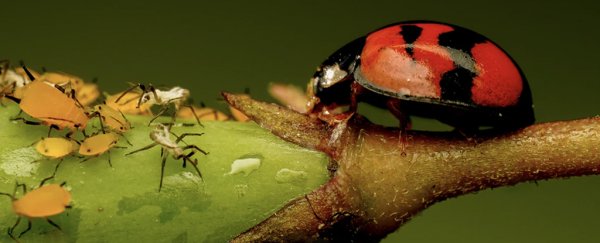While no one enjoys seeing carefully nurtured crops destroyed by hordes of hungry insects, the most common way to prevent it – the use of insecticides – is causing massive ecological problems.
Some are wreaking havoc on bee populations globally, killing birds and piling onto the challenges already faced by endangered species. Thankfully, insecticides are generally only in our food at low levels, but they do harm humans who are highly exposed to them too, like the workers growing our crops.
They also destroy predatory insect populations, which just makes the problem of crop pests worse in the long term - with fewer pest enemies around to keep their numbers in check.
One alternative that researchers and farmers have been putting to the test is the use of predatory insects to control the problematic plant eaters. However, this approach, known as biological control, has its own challenges.
While insecticides can target multiple pest species, this is a lot harder to achieve when relying on natural predators. Releasing multiple predators could just lead to them preying on each other, or competing with each other for the same pest, as predators may not always target their intended species.
The predators are also very reliant on environmental conditions – temperature and day length can alter their behavior so they may only be effective during certain seasons. This, along with the fact that some pests are invasive and have no native predators means some pesticides may still need to be used, which can then also impact the predators.
So insect ecologists Jessica Kansman and Sara Hermann are looking into ways of tweaking the use of pest species' natural enemies to make it more practical. They presented results of their progress at this week's meeting of the American Chemical Society.
In a series of trials the researchers let collard-snacking aphids (Myzus persicae) choose between the scent of leaves with predatory ladybugs (Harmonia axyridis) on them or the smell of leaves with no ladybug.
They found exposure to the ladybug scent impacted the aphids' plant choices and even reduced their reproductive rate.
"Our early work has shown that these fear-based responses can change insect behaviors in ways that reduce their damage on these crop plants," Hermann said in a media briefing.
Aphids are present in almost every crop humans grow worldwide, causing billions of dollars in damage. They have an immense reproductive capacity and they also carry and spread plant diseases much like mosquitoes do in humans. A lot of insecticide use is specifically for the management of aphids, but they are growing resistant.
Bottling the scent of aphids' ladybug nightmares may provide farmers and gardeners with a safer and more sustainable way to manage them.
"I've been trying to identify the smell of danger," explained Kansman.
To do this Kansman and team placed ladybugs into a glass container and pushed sterilized air over the beetle. The air passed through a trap at the container's bottom, which the researchers rinsed and ran the resulting solution through a gas chromatograph mass spectrometer. This separates out different compounds, allowing them to be identified.
Some of the isolated volatile molecules were already known from studying other biological systems Kansman explained, such as terpenes that have various functions in plant defenses and even a chemical known to interfere with aphid's alarm pheromone.
The researchers then puffed individual compounds across an aphid's antennae (their 'smell' organs) and detected the insects' electrical impulse responses using an electroantennogram to see which they responded to.
"We're also measuring their behavioral responses," explained Kansman, such as if "aphids move towards something or not."
Preliminary field tests using three methoxypyrazine compounds (which we humans would recognize as the smell of ladybugs) isolated from ladybug stink have produced promising results - with aphids avoiding the sprayed collard crops as if ladybugs were present.
"The beauty of these compounds being specific to these insects is that it's an honest cue," said Hermann, explaining that the presence of actual predators in the field will help reinforce this cue, hopefully preventing the aphids from becoming resistant to it.
What's more, as ladybugs are major predators, they eat more than just aphids – so potentially the resulting bouquet of danger may deter other pests too. But first, the researchers will also have to check its effects on other beneficial insects and across different types of crops out in the field.
They're planning wider field studies to investigate these remaining questions and are working with companies to develop and trial suitable dispersal mechanisms for their fear-inducing fragrance.
"The use of natural enemy odor cues is a promising future direction for applied chemical ecology in sustainable pest management," the team concluded in their presentation abstract.
